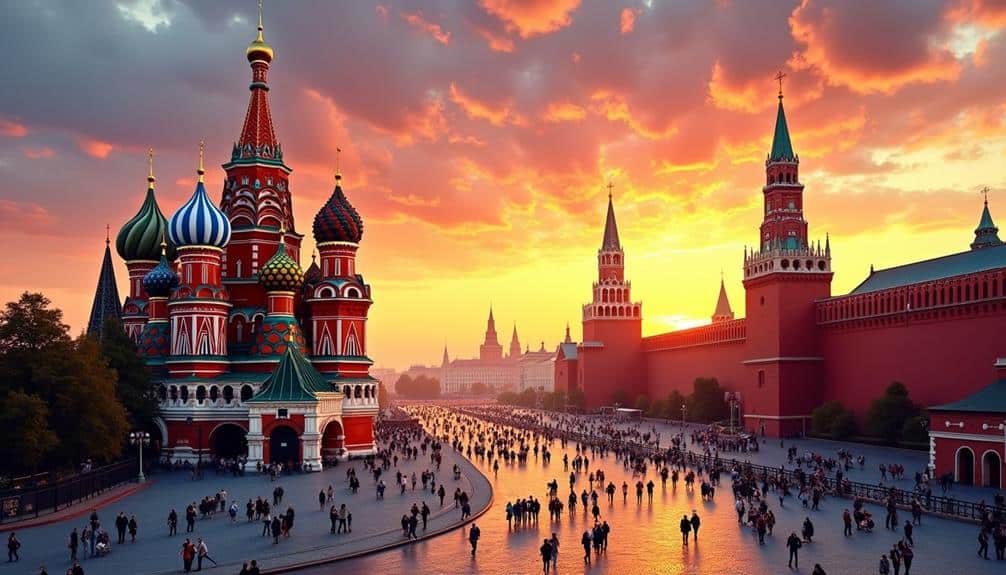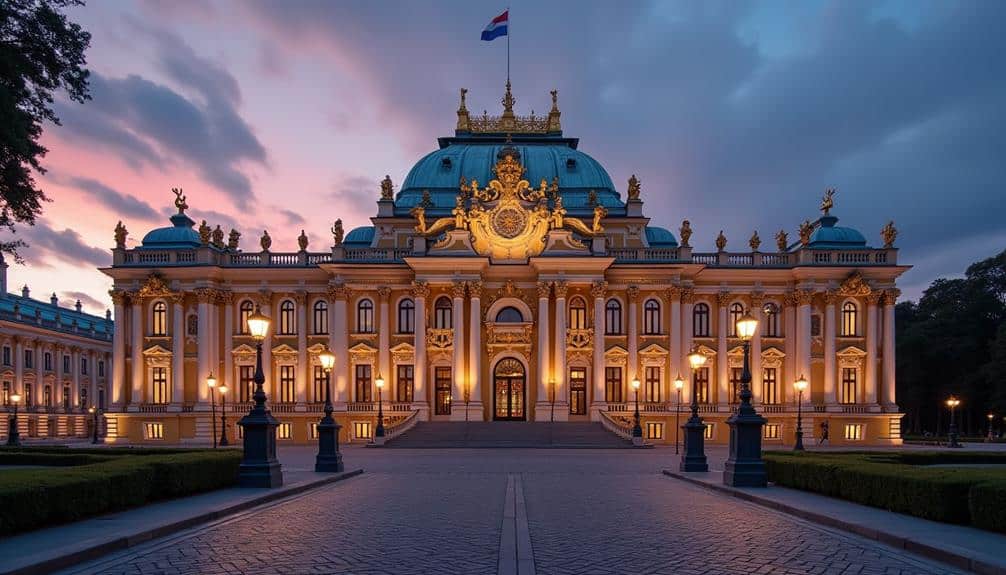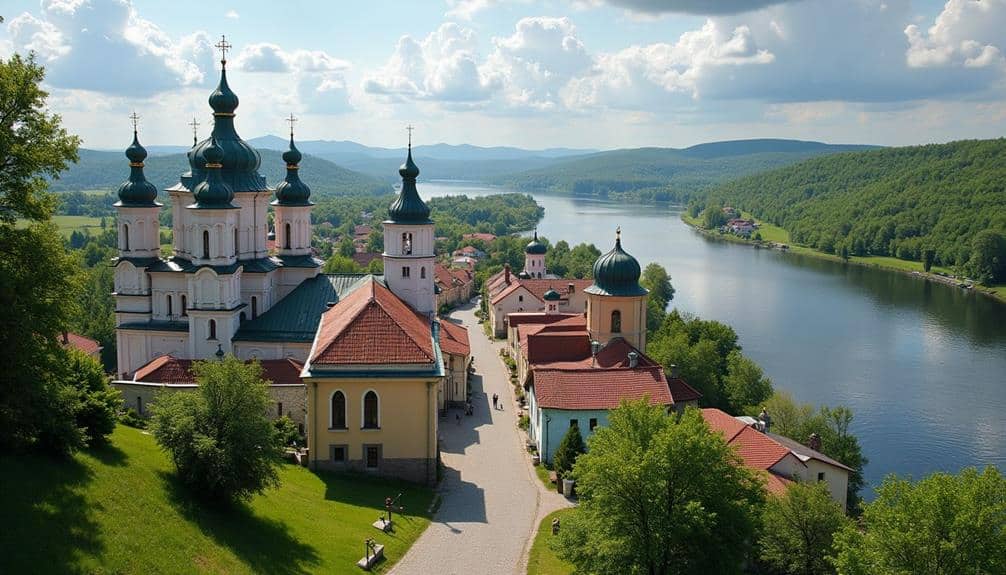A week-long journey through Russia offers an unparalleled opportunity to explore the nation’s richness of historical landmarks, cultural treasures, and natural wonders. Commencing in the bustling capital of Moscow, visitors can marvel at the architectural splendor of Red Square and the Kremlin. The itinerary then leads to St. Petersburg, where the Hermitage and Peterhof Palace await with their opulent displays. The Golden Ring towns promise an in-depth exploration of Russia’s heritage, while Lake Baikal offers a serene retreat. Each stop is a chapter in Russia’s grand narrative, inviting further investigation into their unique allure.
Moscow: Red Square

Situated in the heart of Russia’s capital, Red Square serves as a central focal point of Moscow, brimming with historical and cultural significance. This iconic space has borne witness to the country’s evolving history, from its medieval origins to its current status as a symbol of Russian heritage and pride. Established in the late 15th century, Red Square has transformed over the centuries into a hub for political, social, and cultural activities, making it an essential stop for any visitor to Moscow.
The Red Square history is marked by its role as a marketplace, fortress, and a stage for grand state events. Its iconic architecture includes some of the most recognizable structures in the world, such as the colorful domes of St. Basil’s Cathedral, erected in the 16th century to commemorate Ivan the Terrible’s victory over Kazan.
Additionally, Lenin’s Mausoleum stands as a stark reminder of Soviet history, drawing countless visitors annually. The square’s cobblestone expanse is framed by the State Historical Museum and the GUM department store, blending historical narratives with contemporary culture.
Red Square remains a symbol of Moscow’s dynamic past and its enduring influence on Russian identity.
Kremlin and Armory
The Kremlin and its Armory stand as cornerstones of Russian history and governance, embodying the nation’s rich cultural heritage and political legacy. The Kremlin, a formidable fortress complex in the heart of Moscow, has been the seat of power for centuries. Its walls, cathedrals, and palaces narrate the story of Russia’s evolution from a medieval state to a global superpower.
Visitors to the Kremlin can explore its historical layers, from the Tsarist era to its current role as the official residence of the President of Russia.
Integral to the Kremlin is the Armory Chamber, a museum that houses an unparalleled collection of Armory treasures. This repository includes regalia, weaponry, and artifacts amassed over centuries. Among its most renowned exhibits are the imperial crowns, Fabergé eggs, and the Monomakh’s Cap, a symbol of Russian autocracy.
Each artifact within the Armory offers a glimpse into the opulence and artistry of Russia’s past, reflecting the craftsmanship and wealth of the Tsarist era.
Engaging with the Kremlin history and Armory treasures provides an immersive experience into Russia’s storied past, making it a must-visit for any traveler seeking a thorough understanding of the nation’s grandeur.
St. Petersburg: Hermitage

Discovering the Hermitage in St. Petersburg is a pivotal experience for any visitor. Founded by Empress Catherine the Great in 1764, the Hermitage encompasses one of the world’s largest art collections, housed within a complex of six historic buildings.
The Winter Palace, the former residence of Russian emperors, constitutes the centerpiece of the Hermitage architecture, a stunning example of Elizabethan Baroque style. The grandeur of its facades and the opulence of its interiors reflect the zenith of Russian imperial power.
As visitors traverse the seemingly endless galleries, they encounter the museum’s renowned Impressionist collections. These collections boast masterpieces by Monet, Renoir, and Degas, among others, representing a pivotal period in art history. This assemblage of Impressionist works provides an in-depth look into the transformative techniques and perspectives that shaped modern art.
Beyond the Impressionist collections, the Hermitage offers an extensive array of European, Asian, and Russian art, spanning from antiquity to the modern era.
The museum’s vastness and diversity make it both a cultural treasure trove and a demonstration of human artistic achievement. A visit to the Hermitage is not merely a tour but an immersion into the rich tapestry of global art heritage.
Peterhof Palace
Often referred to as the “Russian Versailles,” Peterhof Palace stands as a tribute to the grandeur and opulence of Russia’s imperial past. This magnificent estate, located just 30 kilometers from St. Petersburg, was commissioned by Peter the Great and serves as a stunning example of 18th-century Russian architecture and landscaping.
The palace complex is renowned for its extensive and meticulously designed gardens, which invite visitors to partake in a leisurely gardens exploration. Spanning over 1,500 acres, these gardens are adorned with numerous fountains, sculptures, and pavilions, each contributing to the estate’s overall splendor.
The Grand Cascade, a series of 64 fountains and over 200 bronze statues, is particularly remarkable, showcasing the engineering prowess of the era.
Inside the palace, visitors are greeted with a collection of architectural marvels. The opulent interior features grand halls, intricate mosaics, and lavish furnishings that reflect the tastes and ambitions of Russia’s rulers.
Not to be missed is the Throne Room, with its richly gilded decor, and the Chesme Hall, adorned with nautical motifs that celebrate Russia’s naval victories.
In essence, Peterhof Palace offers an unparalleled glimpse into the lavish lifestyle of the Russian aristocracy, making it an essential stop on any visit to Russia.
Golden Ring Towns

Nestled in the heart of Russia, the Golden Ring Towns offer an enchanting journey through the nation’s historical and cultural heritage. This collection of ancient towns forms a circle northeast of Moscow and provides an immersive experience into Russia’s past.
Suzdal, a gem of the Golden Ring, is renowned for its well-preserved Suzdal architecture. This town is a living museum with its white-stone cathedrals, wooden houses, and the striking Kremlin.
Walking through Suzdal feels like stepping back into medieval Russia.
Vladimir, another key town, boasts a rich Vladimir history that dates back to the 12th century. Here, visitors can explore the Assumption Cathedral and the Golden Gates, both of which are UNESCO World Heritage sites.
These landmarks stand as symbols of Vladimir’s significance in early Russian history.
Kostroma, the birthplace of the Romanov dynasty, is famed for its traditional Kostroma crafts. The town’s artisans produce exquisite lace, ceramics, and woodwork, reflecting centuries-old techniques passed down through generations.
Yaroslavl, located along the Volga River, is famous for its magnificent Yaroslavl churches. The Church of Elijah the Prophet and the Monastery of the Transfiguration are prime examples, showcasing stunning frescoes and intricate architectural designs.
Lake Baikal Adventure
Lake Baikal’s awe-inspiring beauty and ecological significance make it a must-visit destination on any Russia trip. As the world’s deepest and oldest freshwater lake, it offers unparalleled opportunities to explore Baikal wildlife, including the endemic Baikal seal. The surrounding region’s biodiversity and pristine waters create a haven for nature enthusiasts.
Outdoor activities around Lake Baikal are abundant and diverse. In the warmer months, hiking trails offer access to scenic landscapes, such as the Great Baikal Trail, which showcases breathtaking views of the lake and its lush surroundings.
Winter transforms the area into a playground for ice fishing, snowmobiling, and dog sledding, providing a unique way to experience the lake’s frozen expanse.
Local cuisine is another highlight of a Lake Baikal adventure, featuring dishes that incorporate the region’s abundant fish supply, such as omul and grayling. These culinary delights offer a taste of the area’s rich traditions and natural resources.
Cultural experiences abound in the villages surrounding Lake Baikal, where visitors can learn about the indigenous Buryat people and their customs. Engaging with local communities provides a deeper understanding of the region’s history and cultural heritage, enriching the overall travel experience.




